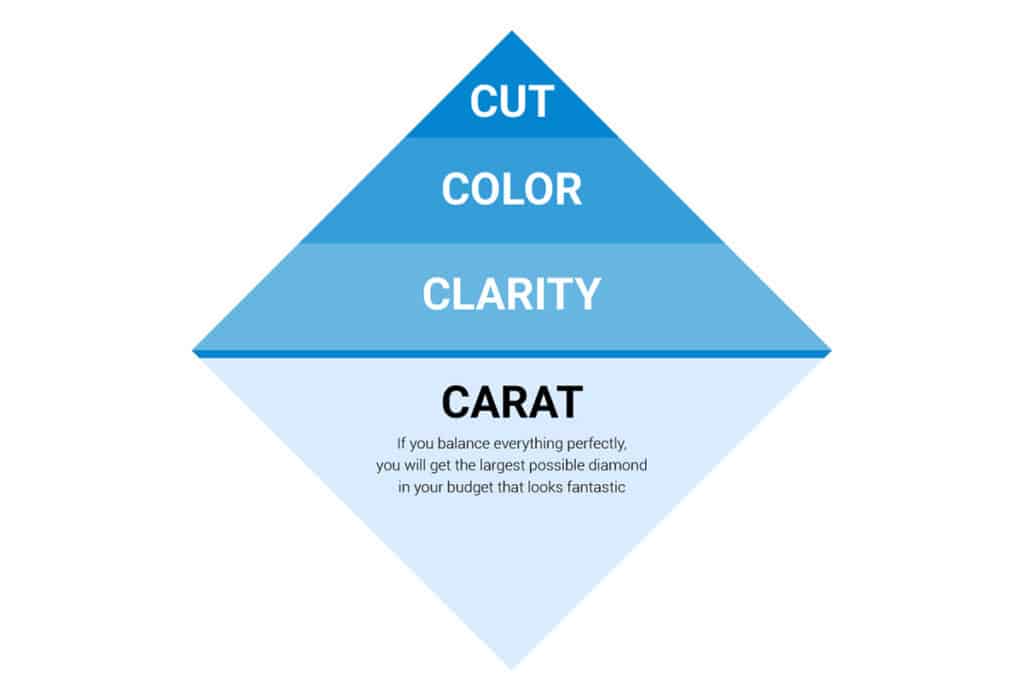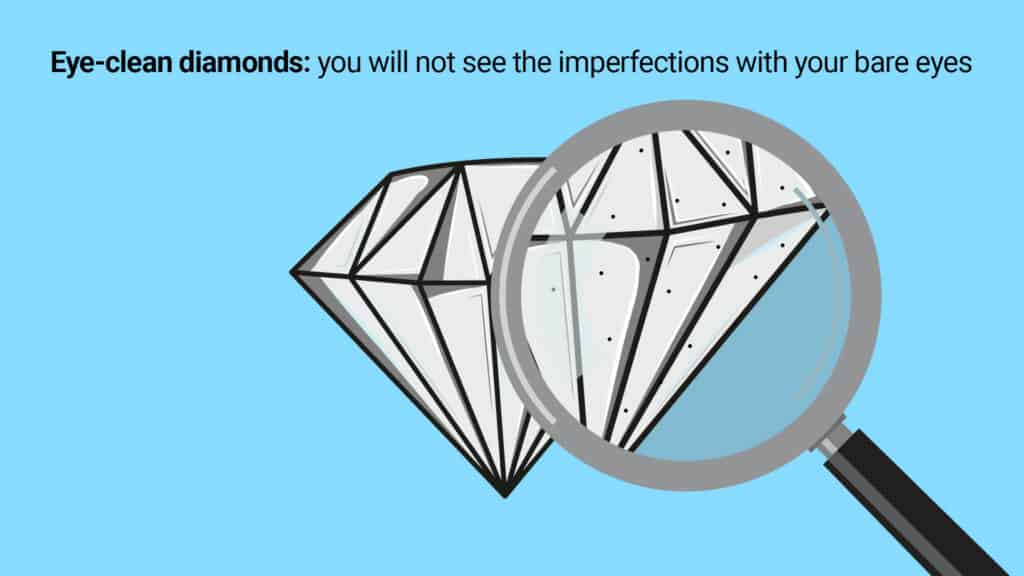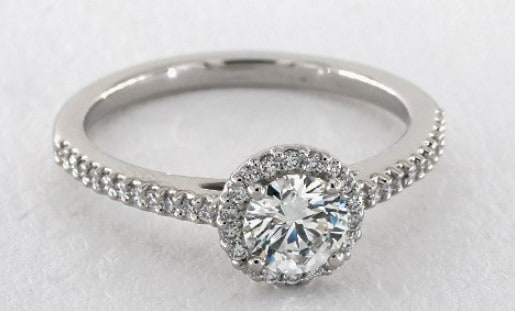There are several ways to shop for a diamond. The first is to select the diamond itself, then pick a setting that matches it while fitting within your budget. The second is to begin with your choice of setting, then select a diamond that both completes and complements it.
This reader went with the second approach: choosing a specific type of setting — in this case, a halo engagement ring in a white metal — then reaching out for our expert help with choosing the right diamond to complete it.
Here’s the reader’s original email:
“Hi,
I’m looking for an engagement ring and would appreciate your advice.
First on the ring. My girlfriend likes white gold or platinum, halo, and pave rings. She also wants the band to be on the thinner side. Based on this I’ve chosen this ring from James Allen:
14K WHITE GOLD PETITE DIAMOND HALO ENGAGEMENT RING
I’m interested in your advice on diamond options to go with it. I don’t have any specific requests except for it to be a white diamond and of good quality (but without overpaying for features that aren’t necessary or won’t even be seen).
I’m willing to spend up to $4,500 including the ring linked above (but if the right combo comes in under that number then all better!).
Let me know what you suggest and if you have any questions.
Also, thank you for the informative website and help in making this decision! A good friend of mine purchased his wife’s ring from you and was very satisfied with the end result.”
Halo diamond rings can look absolutely stunning, especially when the center diamond is picked carefully to match the surrounding loop of smaller diamonds. With this type of setting, it’s vital to choose a diamond that’s well cut and a good color and clarity match for the surrounding stones.
We ended up selecting this 0.80 carat, H color, VS1 clarity round cut diamond from James Allen, which the reader paired with a platinum halo setting. The end result was a stunning engagement ring and — even more importantly — a happy, successful proposal.
Unlike buying a solitaire engagement ring, which is generally a simple process, finding the right diamond for a halo ring can seem significantly more complicated. However, it’s not that difficult once you’re aware of what to look for (and, just as importantly, what to avoid).
Buying a Halo Engagement Ring for $4,500
Halo engagement rings can look truly gorgeous, especially when careful attention is put into the choice of center diamond.
In a halo ring, the center diamond is surrounded by a circular halo of smaller diamonds, typically round brilliant cut diamonds. These surrounding diamonds draw attention to the center diamond and give the ring extra brilliance and presence on the wearer’s finger.
They also have a nice secondary benefit — making the center diamond appear larger and more brilliant than it really is.
Many halo settings also feature pavé diamonds — small, typically round diamonds set inside the band. However, you can also find lots of beautiful halo settings with unadorned bands that draw all of the focus towards the center diamond.
Because of these advantages, halo settings are popular. In fact, a 2020 survey conducted by Shane Co. and reported on by Rapaport found that the halo setting was rated as the favorite setting of Americans in 41 states, as well as Washington D.C.
So, assuming you’ve already chosen a halo setting like this reader, what should you look for in a center diamond?
Let’s begin with the diamond shape. Like with all engagement rings, most halo settings feature a round brilliant cut diamond. This is because round brilliant cut diamonds account for the majority of all diamonds sold.
However, the halo setting doesn’t only look good with a round diamond. Because of its versatile appearance, a halo setting can complement any diamond shape nicely, although it tends to look the best with diamond shapes that are at least partially rounded (e.g. cushion cut, oval shape, pear shape).
Beyond shape, there are several other factors to consider when choosing a center diamond for a halo engagement ring.
1) Diamond Quality – The 4Cs
The first is the quality of the diamond itself. Regardless of setting type, the 4 Cs of diamonds always apply, and it’s critical to choose a diamond that has the right balance of cut quality, clarity, color and carat weight.

As we often state, we recommend prioritizing the cut quality of a diamond, then aiming for clarity that’s eye-clean (meaning a diamond has no inclusions that are visible to the naked eye) and appears colorless in its setting.
For the round brilliant cut, this generally means picking an Excellent (if certified by the GIA) or Ideal (if certified by the AGS) diamond cut grade. We suggest avoiding any diamonds that are sold with certificates from other grading entities, as these often exaggerate the quality of the diamond and make an unattractive diamond look like a good deal.
As for diamond clarity, an eye-clean appearance is more important than a specific clarity grade. You can often find stunning, eye-clean round diamonds under 1 carat in the SI1 to VS2 range — a grade level that can offer fantastic value for money.
Paying more than you need to for clarity is ultimately a waste that takes a greater percentage of your budget away from other features, as in real life, no one’s going to view your diamond under a jeweler’s loupe. Any inclusions that aren’t visible to the eye are, in effect, simply not there.

When it comes to diamond color, the most important point is to select a diamond that appears to be completely colorless in its setting in a real-life environment.
Like with clarity, there’s no need to overpay for perfection. G/H color will look amazing in any halo setting. Because the round brilliant cut does a great job of disguising color due to its exceptional light refraction, in case of a solitaire setting, you can pick a diamond with a color grade in the I – J color range without any significant issues.

2) Compatibility
The second is the level of compatibility between the center diamond and the small diamonds in the halo. By this, we mean that it’s important for the center diamond to either match, or at least come close to matching, the small diamonds that surround it in terms of color and clarity.
Next, let’s go over the compatibility issue. With a simple setting like a solitaire engagement ring, choosing a diamond is very simple. This is because there’s only one diamond — the center one — eliminating the issue of compatibility between the different diamonds.
With a halo setting, the center diamond is surrounded by smaller diamonds. In order to look its best, the center diamond needs to be similar in clarity and color to the small diamonds that will wrap around it to avoid a mismatch.

For example, let’s say you purchase a halo engagement ring that features halo diamonds with G-H average color and VS1-VS2 average clarity, then pick a center diamond with a color grade of L, K or even M.
In this case, the center diamond is at risk of appearing significantly more yellow than the small halo diamonds due to the large difference in color grade, especially if the setting is made from white gold, platinum or another colorless metal.
Solving this problem is simple: just select a diamond with a clarity or color grade that’s equal or similar to that of the diamonds featured in the setting.
You can do this easily by checking the diamond grading in the “Product Details” section on any James Allen engagement ring setting page. For example, we can see that this setting from James Allen features halo diamonds in the G-H color range and VS2-SI1 clarity range:
Blue Nile provides similar information about color and clarity in the “Product Details” section that can be found on each setting’s page.
3) Budget
Finally, there’s the budget factor. Halo settings tend to be more costly than simple settings such as solitaire rings, which means you’ll need to factor in the cost of both the diamond and the ring when you’re planning your purchase.
This reader has a total budget of $4,500, meaning we need to find a diamond that will meet their expectations without causing them to spend more than they’d like to.
In a later email, this reader specified that they’d prefer a platinum setting. This further increases the price of the setting, as platinum is a more expensive metal than white gold. However, it’s still very possible to find a stunning diamond that’s within their price range.

For example, this reader’s choice of setting — an elegant and timeless platinum petite halo ring from James Allen — is available for $1,760. Many settings, including this one, can often be found on sale by shopping at a good time to buy an engagement ring.
Assuming the full price of $1,760, this gives us a total of $2,740 to spend on a center diamond without exceeding their budget.
We can find many impressive round brilliant cut diamonds within this price range. For example, this 0.72 carat, H color, SI1 clarity diamond is available for $2,310, and this 0.72 carat, H color, Si1 clarity diamond is available for $2,580.
In the end, this reader decided to extend their budget slightly and select this 0.80 carat, H color, VS1 clarity round cut diamond from James Allen. It’s a fantastic diamond that will look beautiful in their choice of halo setting.
Our Recommendation
Choosing a halo setting is a great idea if you’re looking for an elegant engagement ring that will emphasize the center diamond’s brilliance. It’s also a good option if you’re looking to create the appearance of a larger diamond without spending too much on a large center diamond.
When choosing a diamond for a halo setting, follow the advice above: prioritize cut quality first, then select a diamond with eye-clean clarity and a color grade that allows it to appear colorless in relation to its setting and the surrounding halo diamonds.
You can compare diamonds and settings using the search tools and filters provided by vendors such as James Allen and Blue Nile.
If you need help with any aspect of the process, from choosing a setting to comparing diamonds for quality and value for money, don’t hesitate to contact us. Our expert team helps hundreds of our readers every month, and we’re happy to help you find and buy your ideal diamond ring.

- No questions asked returns within 30 days of shipment. James Allen will send you a paid shipping label to return the ring.
- Lifetime Warranty
- Free International Shipping
- Free prong tightening, repolishing, rhodium plating and cleaning every 6 months
- Provide insurance appraisals
- One free resizing within 60 days of purchase
- Free ring inscriptions
- Best-in-class high quality imagery of all diamonds in stock
- 24/7 Customer Service
- Best-in-class packaging


- No questions asked returns within 30 days of shipment. Blue Nile will send you a paid shipping label to return the ring.
- Lifetime Warranty
- Free Shipping
- Free prong tightening, repolishing, rhodium plating and cleaning every 6 months
- Provide insurance appraisal
- One free resizing within the first year of purchase
- High quality images of about half of their diamonds
- 24/7 Customer Service
- 100% credit towards future upgrades (must be at least double in value)
- Best in class fulfillment

- 18 Anniversary Beauties for the Classic Diamond and Gold Years (Or Whenever Really)
- Ask a Diamond Pro: Finding a Diamond Pendant on a $5,000 Budget
- Ask a Diamond Pro: Choosing a Radiant Cut With a Gemstone Setting
- Get a Non-Traditional Engagement Ring!
- Ask a Diamond Pro: Clarity vs. Cut for 1.70 to 2.00 Carat Round Diamond

